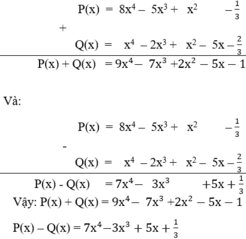
Hãy nhập câu hỏi của bạn vào đây, nếu là tài khoản VIP, bạn sẽ được ưu tiên trả lời.


Sắp xếp hai đa thức theo lũy thừa giảm dần của biến rồi sau đó thực hiện phép tính:


a, 315+(125-x)=435
<=> 125 - x = 435 - 315
<=> 125 - x = 120
<=> x = 5
b, 6x-5=613
<=> 6x = 613 + 5
<=> 6x = 618
<=> x = 103
c, 128-3(x+4)=23
<=> 3(x +4 ) = 105
<=> x + 4 = 35
<=> x = 31
e, -x +8=17
<=> x = -9
a, 315+(125-x)=435
125-x=435-315=120
x=125-120=5
=>x=5
b,6x-5=613
6x=613+5=618
x=618:6=103
c, 128-3(x+4)=23
3(x+4)=128-23=105
x-4=105:3=35
x=35+4=39
Ý D NHẦM ĐẦU BÀI BẠN ƠI.

Tính chất về giá trị tuyệt đối ứng dụng để tìm giá trị lớn nhất, giá trị nhỏ nhất:
\(\left|a\right|+\left|b\right|\ge\left|a+b\right|\) dấu bằng xảy ra khi và chỉ khi \(ab\ge0\)
+) A=|x-2012|+|2011-x|\(\ge\)|x-2012+2011-x|=1
min A=1 <=> (x-2012)(2011-x)\(\ge0\)<=> \(2011\le x\le2012\)(lập bảng xét dấu )
+) B=\(\frac{21.\left|4x+6\right|+23}{3\left|4x+6\right|+5}=\frac{7\left(3\left|4x+6\right|+5\right)-35+23}{3\left|4x+6\right|+5}=7-\frac{12}{3\left|4x+6\right|+5}\)
\(\left|4x+6\right|\ge0\Rightarrow3\left|4x+6\right|+5\ge5\Rightarrow\frac{12}{3\left|4x+6\right|+5}\le\frac{12}{5}\)
\(\Rightarrow-\frac{12}{3\left|4x+6\right|+5}\ge-\frac{12}{5}\Rightarrow7-\frac{12}{3\left|4x+6\right|+5}\ge7-\frac{12}{5}=\frac{23}{5}\)
Vậy \(A\ge\frac{23}{5}\)
min A=23/5 <=> 4x+6=0 <=> x=-3/2

Áp dụng tính chất dãy tỉ số bằng nhau ta có:
\(\dfrac{x_1-1}{5}=\dfrac{x_2-2}{4}=\dfrac{x_3-3}{3}=\dfrac{x_4-4}{2}=\dfrac{x_5-5}{1}\)
\(=\dfrac{\left(x_1-1\right)+\left(x_2-2\right)+\left(x_3-3\right)+\left(x_4-4\right)+\left(x_5-5\right)}{5+4+3+2+1}\)
\(=\dfrac{\left(x_1+x_2+x_3+x_4+x_5\right)-\left(1+2+3+4+5\right)}{15}\)
\(=\dfrac{30-15}{15}=1\)
\(\Rightarrow x_1=x_2=x_3=x_4=x_5=6\)
Vậy...
Áp dụng tính chất dãy tỉ số bằng nhau ta có:
\(\dfrac{x1-1}{5}\)=\(\dfrac{x2-2}{4}\)\(\dfrac{x3-3}{3}\)=\(\dfrac{x4-4}{2}\)=\(\dfrac{x5-5}{1}\)=\(\dfrac{x1-1+x2-2+x3-3+x4-4+x5-5}{5+4+3+2+1}\)=\(\dfrac{x1+x2+x3+x4+x5-\left(1+2+3+4+5\right)}{15}\)=\(\dfrac{30-15}{15}\)=\(\dfrac{15}{15}\)=1
\(\dfrac{x1-1}{5}\)=1 => x1-1=5 => x1 =6
\(\dfrac{x2-2}{4}\)=1 => x2-2=4 => x2 =6
\(\dfrac{x3-3}{3}\)=1 => x3-3=3 => x3 =6
\(\dfrac{x4-4}{2}\)=1 => x4-4=2 => x4 =6
\(\dfrac{x5-5}{1}\)=1 => x5-5=1 => x5 = 6
Vậy x1=x2=x3=x4=x5 =6